Note: due to some new copy protection encoding on the discs, I was unable to get any screen grabs from these UHD discs, and the images that accompany this review are from a previous Blu-ray release and are intended for illustrative purposes only. If my software gets an update, I'll replace these images with actual screen grabs from the UHDs.
I would like to think that the name of French author Alexandre Dumas would be remembered for more than its appearance in The Shawshank Redemption, when a prisoner comically mispronounces it as “Alexandree Dumb-ass.” Dumas was, after all, responsible for one of the most beloved of all adventure tales, Les Trois Mousquetaires, or as it’s more widely known the world over, The Three Musketeers. Even today, almost 180 years after it was first published, it remains a rollicking tale of swashbuckling heroism, friendship, skulduggery, honour and revenge, peppered with moments of real wit and humour. And the titular musketeers’ credo, “All for one, and one for all!” is almost as famous as the story that gave it birth.
Dumas’ novel has proved a popular subject for cinematic interpretation, with Wikipedia listing close to 40 film adaptations to date. Despite my fondness for the novel, I’ve not seen anything like all of these movies, but of those I have watched, my favourite has always been the 1973 The Three Musketeers (The Queen’s Diamonds) and its 1974 follow-on, The Four Musketeers (The Revenge of Milady). On paper, the two films have quite a pedigree, having initially been set up as a single movie by producers Ilya and Alexander Salkind, who then brought director Richard Lester on board. It proved a timely project for this sometimes undervalued filmmaker, who first came to worldwide prominence with the Beatles movies A Hard Day’s Night and Help!, but in the early 1970s was struggling to find film work after the commercial failure of How I Won the War (1967) and The Bed Sitting Room (1969). These films, it turns out, would put him back on top. They were photographed by ace cinematographer David Watkin, the fights were choreographed by top swordsman William Hobbs, and as for the cast, well, I’ll get to that in a minute. It was apparently Lester who brought author George MacDonald Fraser on board to pen the screenplay, having wanted to make a film adaptation of Fraser’s novel Flashman for some years. As it turns out, the success of the Musketeers films allowed him to realise his dream in 1975 with his film adaptation of the second of Fraser’s Flashman novels, Royal Flash.
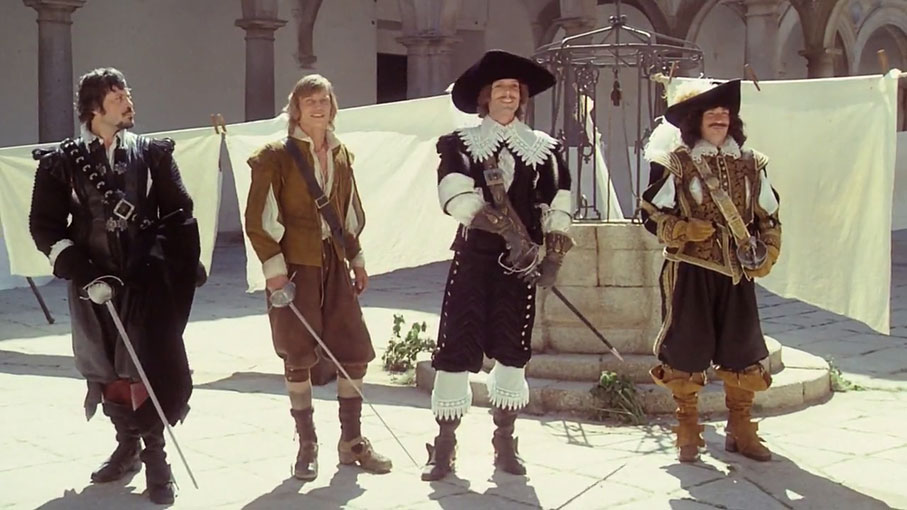
Although the two films were originally intended as a single three-hour movie with a midway intermission, a decision was made by the Salkinds to divide the film in two and release them as separate films,* potentially doubling the project’s box-office takings. This did not go down so well with several prominent members of the cast and crew, however, who knew nothing of this decision until the premiere of the first film and were incensed that they had effectively made two movies but only been paid for one. This led to lawsuits and ultimately to action by the Screen Actors Guild that resulted in what became known as the ‘Salkind Clause’, which stipulated that a single production could not be split into multiple films without prior contractual agreement of all of those involved. Thus, despite that fact that they were released as separate titles in cinemas, both films are essentially two halves of a single adaptation of The Three Musketeers as written by Dumas. It’s for this reason that I’ve elected to cover both films in a single review, despite the fact that Studiocanal has also released the two films individually on UHD, Blu-ray and DVD. It also makes sense because if you’re planning on buying one of the two films, you’re very likely also going to want the other, or you’re going to be missing out on half of the story. The first film even ends with what is effectively a trailer for the second, a not-so subtle prod to buy a ticket to see that one too.
So what’s it about? You really have to ask? Okay, to be fair, not every film version sticks strictly to the story and the detail of the novel, so it’s quite possible to have only seen a version of The Three Musketeers that is not true to Dumas, and one of the real strengths of MacDonald and Lester’s adaptation is how faithful so much of it is to the original text. It opens with a stylised title sequence sword fight that wouldn’t be out of place at the front end of a top-drawer 1970s martial arts movie. As this concludes, it’s revealed that the younger of the two combatants, country-born d'Artagnan (Michael York), is being trained in swordsmanship by his father (Joss Ackland), who then gives him his sword and a letter of introduction to his old friend Monsieur de Tréville, the commander of the King’s Musketeers in Paris. The young man thus heads off to the capital city, a journey that is interrupted when his cart horse and bumpkin clothing are disdainfully mocked by Compt De Rochefort (Christopher Lee), an agent for the powerful and influential Cardinal Richelieu (Charlton Heston). Acting on his father’s advice to fight as many duels as possible, he challenges De Rochefort and is immediately knocked out by Rochefort’s men, though recovers in time to see a carriage in which the beautiful but ruthless Milady de Winter (Faye Dunaway) is travelling pause its journey long enough to reveal that she and Rochefort are in cahoots.
After arriving in Paris and being told by de Tréville that he is unqualified at present to become a musketeer, d'Artagnan manages to unintentionally insult and subsequently fix appointments to fight duels with three separate men, who turn out to be Athos (Oliver Reed), Aramis (Richard Chamberlain) and Porthos (Frank Finlay), the titular trio of King’s musketeers. When Athos arrives at the appointed place and time with his friends Aramis and Porthos acting as his seconds, all three react with disbelief that they are scheduled to duel with the same brash young man in quick succession. Before the first fight can begin, however, the four men are accosted by a group of Cardinal Richelieu's guards, who attempt to arrest them for illegally duelling in public. The musketeers opt to fight them, a battle in which they are joined by the enthusiastic d'Artagnan, whose efforts in helping them to defeat their foes earn him their immediate respect and friendship. With his share of the money procured from their deafeted enemies, d'Artagnan procures a servant named Planchet (Roy Kinnear) and rents a room from sleazy landlord, Monsieur Bonacieux (Spike Milligan). Although initially disgusted by the state of the accommodation offered, he gleefully accepts when he meets Bonacieux's beautiful young wife Constance (Raquel Weklch), who works a dressmaker to Queen.
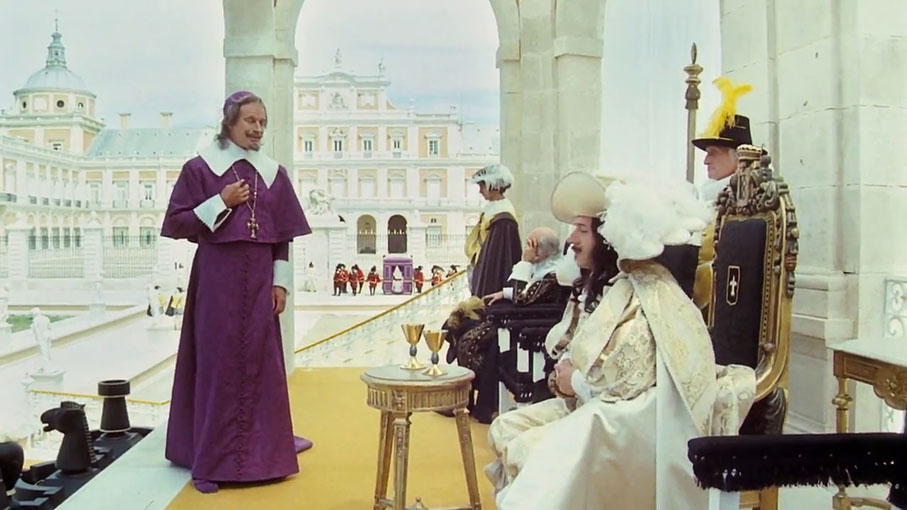
And this is just the basics of the setup. We’ve yet to meet the foppish King Louis XIII (Jean-Pierre Cassel, voiced by Richard Briers), his wife Queen Anna (Geraldine Chaplin), and the Duke of Buckingham (Simon Ward), with whom Anna is having a secret affair. This becomes the target of a plot devised by Richelieu to trigger a war with England, a plan involving necklace presented to the Queen by her husband, two diamond studs from which she gives to the departing Buckingham as a memento. When the studs are stolen by the ruthless and duplicitous Milady de Winter, the Cardinal suggests to the King that the Queen should wear the necklace he bought her to an upcoming soiree that he has arranged, then produce the missing studs when the Queen is unable to explain their absence. It thus falls to d'Artagnan and the Musketeers to save the day.
Coming back to The Three Musketeers after a break of several years was an interesting experience, with some of the things that I once really liked still impressing, others not working quite as well as I recall, and a couple playing even better than I remember. The chief casualty for me is Richard Lester’s way with daffier humour, some instances of which now seems almost quaintly dated. Probably the weakest scene in this regard is d'Artagnan’s lightning-fast seduction of Constance, which now feels unconvincing and a weeny bit creepy, an attempt by this young would-be musketeer not to woo the object of his desire, but to clamber into her knickers as quickly as possible. It doesn’t help that he uses lines that only a naïve nitwit would fall for, which at this point Constance is unfortunately cast as. Elsewhere, the comedy fares better and occasionally is inspired. Spike Milligan’s portrayal of Bonacieux may play at times like a one-man show, but when brought before the Cardinal in his nightwear, his instant retraction to Rochefort’s arrival – “That is the man!” “Take him to the dungeon.” “That is not the man!” – still has me sniggering on every viewing. The slapstick elements are a little uneven, working best when incorporated into the fight choreography, though the visual gag in which a drunken and injured Athos falls backwards down a well whilst swigging his wine is one of the best in the film.
The film’s strengths, however, easily outweigh these minor weaknesses. For start, it has an absolute belter of a cast, with many of the actors delivering performances that are up there with their best. Christopher Lee does a lovely line in pompous arrogance as Rochefort, and it’s been noted that the eye patch he sports here – no mention of which is made in the Dumas novel – has been worn by every screen incarnation of Rochefort since. It may seem surprising to see a star of Charlton Heston’s status in what is effectively a supporting role, but he absolutely nails Richelieu as the true and dangerous power behind the throne, able to manipulate and intimidate others without raising his voice or explicitly stating what he wants or intends. His final scene in the second film is a small masterclass in communicating as much through body language as dialogue and delivery. Faye Dunaway is both strikingly seductive and deliciously malevolent as Milady de Winter, the epitome of the term ‘beautiful but deadly’ in a performance so magnetic that it’s hard to take your eyes off her when she’s on screen – just watch her expression when observing the Duke of Buckingham undress after she has successfully seduced him. Geraldine Chaplin is appropriately downcast as Queen Anne, an interesting contrast to Simon Ward’s confidently likable Duke of Buckingham. About Raquel Welch’s drippy and accident-prone Constance I’m still not so sure, at least as she’s portrayed in the first film. More on that in a minute.
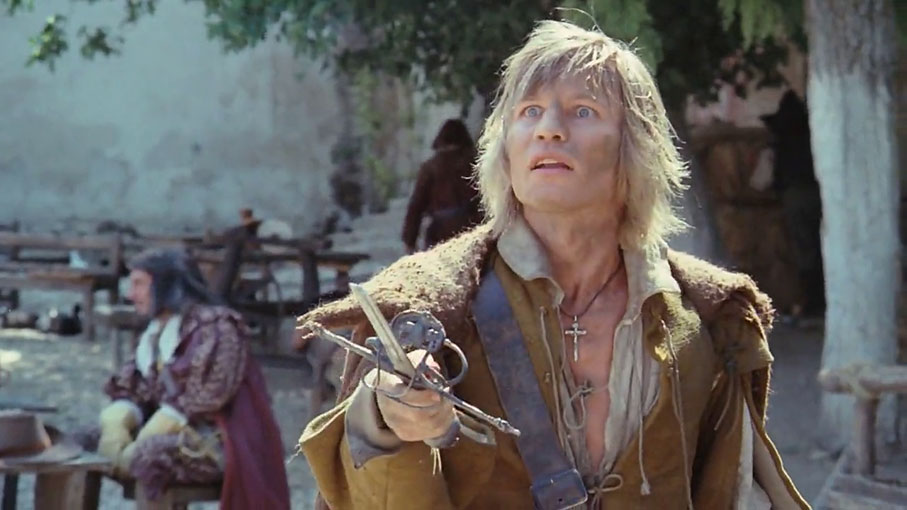
When it comes to the leads, Michael York makes for a sublime d'Artagnan, a proud and fiery ball of youthful energy and enthusiasm with a dazzler of smile and eyes that are constantly wide with hopeful determination. Richard Chamberlain and Frank Finlay are delightfully cast as Aramis and Porthos, the former torn between his religious calling and his taste for the finer things, the latter a serial gambler with a fondness for fine clothing and who seems to be chasing a fortune he is unlikely to ever make. But stealing every scene he is in is Oliver Reed as Athos, a maudlin man who drinks at every opportunity to mask the still painful memory of a blissfully happy marriage that came to a painful end. While it may seem like stereotypical casting to have Reed play the drinker of the three given the actor’s reputation on that score, he commits himself completely here, delivering every line with the sincerity of a man who believes strongly in every word he says, and launching into battle with a ferocity that apparently had even stunt men nervous about going up against him. He really is on fire here, whether angrily goading an enemy to attack or quietly offering advice to their young new recruit. In one of my favourite small Reed moments, the impoverished musketeers enter an inn and start a fight in order to sneakily steal some food as they do battle, and as a surprised and unaware d'Artagnan makes a move to intervene, Athos stops him with a restraining hand, a serious expression, and a single raised finger. Honestly, it works better on screen than I could ever describe it.
Both films look terrific, thanks in no small part to an excellent use of real Spanish locations, Brian Eatwell’s production design, Les Dilley and Fernando González’s art direction, and Yvonne Blake’s period costumes. Bringing them all vividly to life is top cinematographer David Watkin, who had previously shot Lester’s The Knack ...and How to Get It (1965), Help! (1965), How I Won the War (1967) and The Bed Sitting Room (1969) and would work with him again on Robin and Marion (1976) and Cuba (1979). He later won awards for his work on Chariots of Fire (1981) and Out of Africa (1985), but we still cherish him at Outsider for his collaborations with Ken Russell on The Devils (1971) and The Boy Friend (1971). Here he takes his cue from Lester’s keen desire for period authenticity by not overly beautifying the images and adding to the sense that this was how these locations would look if we could travel back in time and see then for real.
The fight choreography by William Hobbs kicks against the slick duels of classic Hollywood swashbucklers by stripping hand-to-hand combat of its former movie glamour and grounding it in a degree of rough-and-ready reality. Swords do not dance with each other at length and high speed here, but are thrust in opportune lunges and often miss their target, and just about anything at hand can be grabbed and thrown or wielded as a makeshift club, with even a wet sheet used as an offensive weapon. Combatants stumble and make mistakes, and there really is a sense here that they are fighting to win at any cost, with little regard for traditional duelling protocol. Rounding things off in the first film is a rousing score by Michel Legrand, the renowned and ferociously busy French composer whose five 1964 credits include the music for Jacques Demy’s every-word-sung musical, The Umbrellas of Cherbourg (Les parapluies de Cherbourg), and Jean-Luc Godard’s style-setting Bande à Part. When he passed on scoring The Four Musketeers film after being required to complete the score for its predecessor in just ten days, the baton was picked up by Lalo Schifrin, whose score differs from Legrand’s in a way that feels appropriate for the second film’s tonal shift.
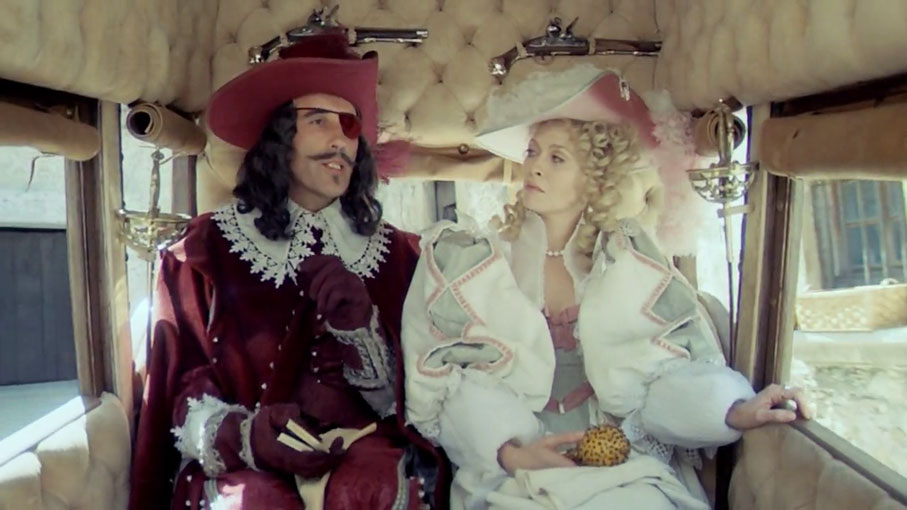
So what of The Four Musketeers? Talking about it in detail is a little tricky when you’ve elected to cover both films in a single review, as this is essentially the second half of a story that began in The Three Musketeers, and any plot developments I discuss run the risk of acting as spoilers for the first film. I’m thus going to sidestep that to focus instead on what the second film does well, and I mean does really well.
Given that both films were shot at the same time, all the positives I listed above about The Three Musketeers also go for The Four Musketeers, and there’s thus a continuity of style, direction and acting that is rare for a sequel and makes it easy to watch them together and see them as the single work that they were originally intended to be. That said, my first viewing of the second film in many years also had a few surprises, as while I once originally saw them as equals, for me, The Four Musketeers has aged even better than its predecessor. The comedy has been dialled back a few notches here, which structurally would have made complete sense had the two films been released as one, where the upbeat adventure of the first half would have taken a back seat as the story moves into a new darker new phase and personal vengeance becomes the key motivating force. Several of the characters are fleshed out a little more here, notably Athos, who in a beautifully directed and acted scene recalls to d’Artagnan the relationship that drove him to drink, the details of which I’ll not elaborate on, lest there are those reading this who are new to the story. Reed really comes into his own here in his sadly whispered memories, and again later when he assures Milady in no uncertain terms what he’ll do to her if she harms d’Artagnan, leaving us in no doubt that he’d see the threat through. While we’re on the subject of Milady, Faye Dunaway also has more to work with in the second movie and is even more dastardly, hell bent on revenge, and at one point manipulating a man who has been judged as resistant to her charms into not only assisting her, but betraying and even murdering someone to whom he was previously loyal. Rachel Welch also feels less like narrative window dressing as Constance this time around, her kidnapping by Rochefort’s men kicking d’Artagnan and his comrades into action, and when chained up in her cell, her seductive smiles to every captivated jailer who brings her food bring her food are quickly followed by a smart kick to the balls.
One thing the second film is frequently championed for is its action set-pieces, and they really are something, being creatively devised and blisteringly staged. A bet made by the musketeers that they will eat breakfast in the St. Gervais bastion in the midst of a battle with protestant rebels at La Rochelle is played partly for fun, but it also moves the plot forward and things get more serious in a superbly choreographed swordfight on the slippery surface of an iced-over pond, and a spectacular climactic battle at the Armentières convent, where all four musketeers fight individually for their lives as buildings burn around the for real and threaten to come down on their heads. It’s also in the last half-hour that the story takes its darkest turns, darker indeed than anything hinted at in the jovial energy that was the driving force of the first film. In this, the film sticks to the novel – a couple of details may have been changed, but the narrative and character fates all follow the exact same path.
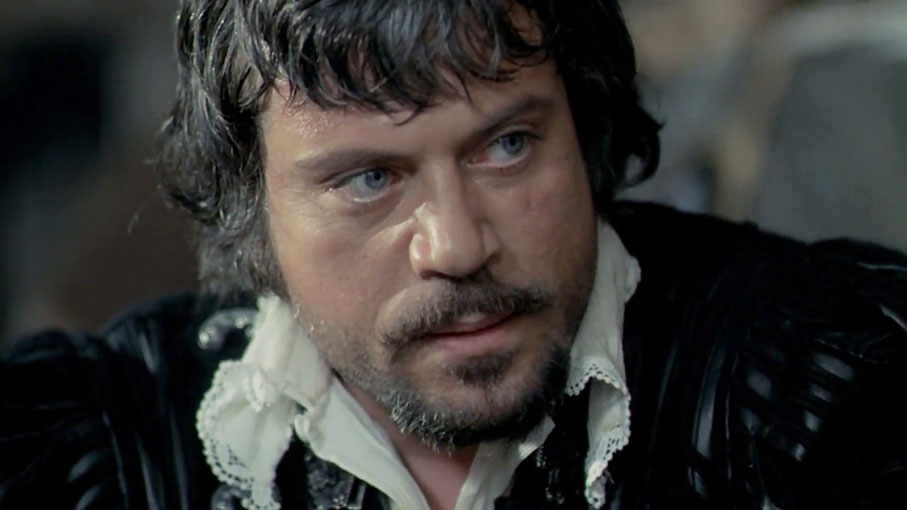
Although released as seperate films, both in the cinema and now on UHD, Blu-ray and DVD, I’ve always seen them as one, and this is how they should be watched. They are, for the most part, impressively faithful to the original Dumas text, and despite my minor quibbles about some of the more dated humour, these movies still make for rousing, thrilling and hugely enjoyable entertainment. Superbly scripted by George MacDonald Fraser, they’re directed with real verve by Lester, whose attention to detail – particularly background detail that slyly comments on life for those not fortunate enough to move in royal, religious or military circles – enriches an already lush dramatic tapestry. It boasts a cast to die for on often fabulous form, and by opting not to deviate significantly from its source material, the films tell one of the finest adventure tales in literary history, and with a wit, skill, attention to detail, and a focus on character and storytelling that is amongst the genre’s best. It's also more fun than any other film adaptation. All together now: “All for one…and one for all!”
The result of a new 4K restoration, these were two films I was excited to see get a UHD upgrade. The resulting 1.85:1 transfers are really good, if just a little shy short of great. I’m aware that any such restoration is at the mercy of whatever source materials the team has to work with, but it’s also important to take on board the lighting, production design and costume choices that the filmmakers made. With this in mind, the image here is decently sharp and with an often very good level of detail, but there are times when this feels like a good Blu-ray level of detail, though intermittently it does rise above that, particularly on close-ups of faces or costumery. The colour palette varies a little in a manner that feels deliberate, subdued in places but having a strong pastel leaning to it in certain scenes – the palace courtyard gathering at the end of the first film is a good example – while the flames of the convent fire at the climax of the second film are vividly rendered. It's certainly an improvement all round on the previous Blu-ray releases from which the screen grabs here have been taken. Contrast is robust in places and softer in others, and just occasionally looks just a tad washed-out, but this is more often than not due to the lighting conditions (a backlit image of the musketeers on horseback where dust is being kicked up, for instance, or the wide shot of Milady walking through a sunbeam-lit convent corridor). As you would hope, there is no trace of obvious damage, and dust and other wear has been cleaned up. What difference the HDR makes is a hard call without comparing these transfers to those on the Blu-ray, but shadow detail is consistently good here. A fine film grain is visible throughout, and I saw no obvious evidence of DNR. Not quite showcase transfers, perhaps, but still very nice.
The Linear PCM 2.0 mono soundtracks are in very good shape, being clear, free of obvious signs of wear or damage, and boasting an impressive tonal range for a mono track, particularly in the robustness of the bass and high treble elements of the respective scores. Being Studiocanal discs, the original English language track is supplemented by French and German dubs. Of the two, the German is superior for mixing the voices correctly to the acoustics of the scenes in question – the French too often sounds like the post-production dub that it is.
French and German subtitles are also provided, as are English subtitles for the deaf and hearing impaired.
THE THREE MUSKETEERS
Interview with Neil Sinyard (31:20)
Film historian Neil Sinyard looks at the importance of The Three Musketeers in the career of its director, Richard Lester, whose film career up to this point he also summarises, as well as detailing the process of getting the film into production. He is able to speak with authority on specific aspects of the film and its making because he has personally interviewed Lester about it, and thus confirms that it was Lester who brought George MacDonald Fraser on board, adding that the quality of his dialogue was widely praised by critics. The casting of the film is covered, with comments passed on individual actors, and I loved Michel Legrand’s description of his own score as “a combination of courting the period and wringing its neck.”

The Saga of the Musketeers, Part 1 (23:10)
The first episode of a two-part retrospective documentary on the making of The Three Musketeers, directed by David Gregory for a 2002 Blue Underground DVD release. What impresses here is that Gregory and his team were able to interview so many of the key players, including producer Ilya Salkind, studio production head Pierre Spengler, production designer Brian Eatwell, and actors Michael York, Frank Finlay, Charlton Heston, Raquel Welch and Christopher Lee. A lot of ground is covered, with Salkind recalling how he, his father Alexander and his grandfather Michael went from near bankruptcy to becoming one of the most successful producing teams in the business, and explaining why they picked Richard Lester to helm the film and what ultimately persuaded him to do it (he read the novel). The actors talk about their characters and being cast in their respective roles, Eatwell claims that you could get anything you wanted through bribery in Franco’s Spain, and York and Finlay recall being instructed by Welch’s people on how to properly behave towards her and even address her, only for Welch herself to arrive on set and quickly become part of the troop. They all heap praise on Lester, and Welch admits to wondering at one point if they were having too much fun making this movie. In the spirit of the film itself, this ends with extracts from its second part, which is on the disc of The Four Musketeers and focuses almost exclusively on that film.
The Making of the Musketeers vintage EPK (6:47)
A typically lightweight pre-release promo for the film, in which Richard Lester talks about striving for period authenticity, some of the actors comment on the characters they play, and Michael Legrand notes that he usually has a couple of months to compose a score but this time was given only ten days. There’s also a welcome sprinkling of behind-the-scenes footage and even a brief glimpse of a swordfight rehearsal. Not exactly pin sharp and a little drained of colour, but interesting nonetheless.
Being able to compare the Original US Trailer (3:02) with the Original UK Trailer (2:36) is rather useful. Accents of the narrators aside, the two trailers both do a decent job of selling the action and intrigue of the film, though both only hint at the comedy. For my money, the UK trailer is the more smartly assembled of the two. Both unsurprisingly showcase the cast, but while the US trailer does this up front, the UK version saves it for the end.
THE FOUR MUSKETEERS
Interview with Neil Sinyard (23:10)
The second half of the interview with Neil Sinyard focuses on The Four Musketeers, which Sinyard notes up front is not a sequel but the second half of what is essentially a single film. There’s considerable focus on the darker and less comedic tone of the second movie, which is reflected in a shift in the BBFC certification from the U of the first film to the A (or PG, as Sinyard updates it) of the second, and even in replacement composer Lalo Schifrin’s score. Sinyard’s observation that no-one actually dies in the first film and that there are several deaths in the second is an astute one, and he reveals that both he and screenwriter George MacDonald Fraser prefer Four over Three, a point on which I am in complete agreement. Ultimately, though, he believes that they work best as two halves of the same film and in that respect are two of Lester’s best. As a big fan of Lester’s superb but undervalued 1974 Juggernaut, I also cheered at his praising of that film as a “brilliant political thriller.”

The Saga of the Musketeers, Part 2 (24:53)
The second half of the Blue Underground documentary is essentially more of the same with the same interviewees, but I have no problem with that. The very physical stunts and sword fights (using real swords, we are assured) and the injuries that resulted are discussed, and Christopher Lee makes of point of stating, “I was 20 years older than the others at least, and a far better swordsman than any of them – I want that on record.” The actors recall working with Spike Milligan and how much he made them all laugh, with Heston unexpectedly opining that he gave one of the best performances in the film. The actors pay tribute to Oliver Reed and Roy Kinnear, both of whom had by then passed away, and Welch recalls her surprise at a newspaper story claimed she had been having an affair with Reed, only to find out from Reed that he had made the whole thing up in order to give the tabloids something juicy to print. A famous gag Reed pulled involving fake goldfish is recalled, Eatwell remembers losing hair because the stress of the shoot, and the decision to split the film into two is discussed.
Original Trailer (2:50)
A UK trailer in the style of the one for the first film, but this time with the star cast of actors listed midway through. A breezy and rather nicely edited sell.
I have to admit that the transfers don’t quite hit the UHD heights I was hoping for, but they’re still pretty darned good and cope well with the film’s naturalistic look and gentle, often pastel-leaning colour palette. The special features are limited in number but are still welcome and informative, particularly Neil Sinyard’s evaluations of both films. As I intimated above, if you plan to get one of these films, I’d budget to also get the other, as they are essentially two halves of the same movie. It’s hard for me to unreservedly recommend the UHDs over Blu-rays without having the latter to compare with, but the bigger your screen size, the better the case for the UHD releases probably is. Either way, the films are still an absolute joy, and remain my favourite adaptation of the Dumas novel. How, then, could I not heartily recommend these?
|